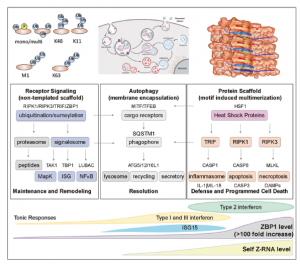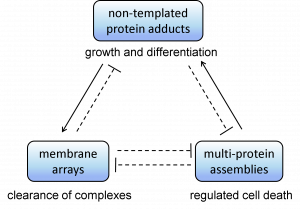Different Diseases Involve Distinct Biochemical Scaffolds, None of Which are Genetically Templated
A different way of understanding the relationship between egenes and disease
CHARLESTOWN, MA, UNITED STATES, May 29, 2024 /EINPresswire.com/ -- In a paper just published in the well-regarded Genes and Immunity, Alan Herbert addresses the question of how genetic diseases relate to the more common diseases that occur as we age. Interestingly, both outcomes depended on biochemical scaffolds that are not templated by sequences in the human genome. These scaffolds are based on three different principles (Figure 1). One kind decorates proteins with modifications on which other proteins can interact to perform their function. A second kind forms on membranes to allow clearance of cellular complexes to limit their persistence. A third kind uses simple amino acid motifs to build protein fibers that dock other proteins to amplify particular outcomes. By switching between scaffolds, a cell can balance their actions to maintain normal function.When one or other scaffold starts to dominate, either due to a genetic variant or to some environmental exposure, the risk of disease increases. Dr. Herbert analyzes the rare condition of osteogenesis imperfecta to exemplify how these complex interactions are regulated during development and relates this to other diseases where related variants increase the risk of Parkinson’s disease. Other diseases, often referred to as complex disease, depend upon the persistence of specific scaffolds that sustain a particular pathological process. In the extreme cases, scaffolds can become dysregulated and disrupt signaling to maintain a chronic inflammatory state and to prolong survival of cancer cells, cause the overactive clearance of cellular contents, with proteins removed as fast as they are produced leading to loss of vital functions, while persistent protein assemblies can lead to agenesis, aplasia, or atrophy by inducing cell death of progenitor cells (Figure 2).
The switches that maintain the scaffolds in a balance state offer places where interventions can improve outcomes. While many small molecules work in this fashion, exploration of other approaches based on RNA regulators, such as those encoded by flipons, has just begun. The recent success of RNA-based therapeutics in the clinic shows the promise of such approaches.
About InsideOutBio: InsideOutBio is a start-up focused on developing a novel class of proprietary therapeutics to 'light' up tumors for the immune system to kill by reprogramming self/nonself pathways within cancer cells. Dr. Herbert leads discovery at InsideOutBio. His work on Z-DNA was foundational to the discovery of flipons. These statements about InsideOutBio comply with Safe-Harbor laws. They are forward-looking and involve known and unknown risks and uncertainties. They are not guarantees of future performance and undue reliance should not be placed on them.
Alan Herbert
InsideOutBio, Inc
+1 617-584-0360
email us here
Visit us on social media:
X
LinkedIn
Legal Disclaimer:
EIN Presswire provides this news content "as is" without warranty of any kind. We do not accept any responsibility or liability for the accuracy, content, images, videos, licenses, completeness, legality, or reliability of the information contained in this article. If you have any complaints or copyright issues related to this article, kindly contact the author above.


